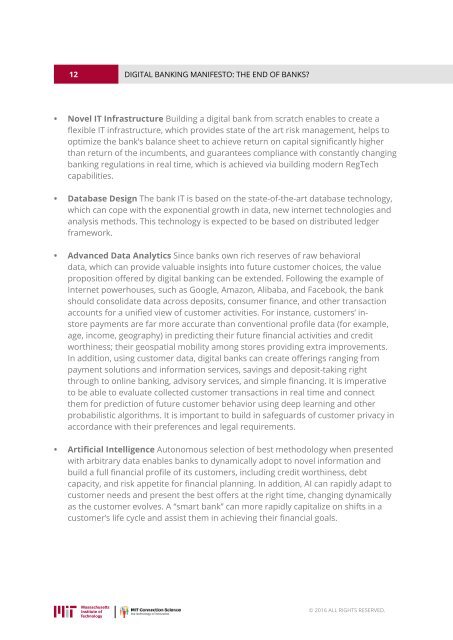Digital Banking Manifesto The End of Banks?
2cS8Ueo
2cS8Ueo
Create successful ePaper yourself
Turn your PDF publications into a flip-book with our unique Google optimized e-Paper software.
12<br />
DIGITAL BANKING MANIFESTO: THE END OF BANKS?<br />
• Novel IT Infrastructure Building a digital bank from scratch enables to create a<br />
flexible IT infrastructure, which provides state <strong>of</strong> the art risk management, helps to<br />
optimize the bank’s balance sheet to achieve return on capital significantly higher<br />
than return <strong>of</strong> the incumbents, and guarantees compliance with constantly changing<br />
banking regulations in real time, which is achieved via building modern RegTech<br />
capabilities.<br />
• Database Design <strong>The</strong> bank IT is based on the state-<strong>of</strong>-the-art database technology,<br />
which can cope with the exponential growth in data, new internet technologies and<br />
analysis methods. This technology is expected to be based on distributed ledger<br />
framework.<br />
• Advanced Data Analytics Since banks own rich reserves <strong>of</strong> raw behavioral<br />
data, which can provide valuable insights into future customer choices, the value<br />
proposition <strong>of</strong>fered by digital banking can be extended. Following the example <strong>of</strong><br />
Internet powerhouses, such as Google, Amazon, Alibaba, and Facebook, the bank<br />
should consolidate data across deposits, consumer finance, and other transaction<br />
accounts for a unified view <strong>of</strong> customer activities. For instance, customers’ instore<br />
payments are far more accurate than conventional pr<strong>of</strong>ile data (for example,<br />
age, income, geography) in predicting their future financial activities and credit<br />
worthiness; their geospatial mobility among stores providing extra improvements.<br />
In addition, using customer data, digital banks can create <strong>of</strong>ferings ranging from<br />
payment solutions and information services, savings and deposit-taking right<br />
through to online banking, advisory services, and simple financing. It is imperative<br />
to be able to evaluate collected customer transactions in real time and connect<br />
them for prediction <strong>of</strong> future customer behavior using deep learning and other<br />
probabilistic algorithms. It is important to build in safeguards <strong>of</strong> customer privacy in<br />
accordance with their preferences and legal requirements.<br />
• Artificial Intelligence Autonomous selection <strong>of</strong> best methodology when presented<br />
with arbitrary data enables banks to dynamically adopt to novel information and<br />
build a full financial pr<strong>of</strong>ile <strong>of</strong> its customers, including credit worthiness, debt<br />
capacity, and risk appetite for financial planning. In addition, AI can rapidly adapt to<br />
customer needs and present the best <strong>of</strong>fers at the right time, changing dynamically<br />
as the customer evolves. A “smart bank” can more rapidly capitalize on shifts in a<br />
customer’s life cycle and assist them in achieving their financial goals.<br />
© 2016 ALL RIGHTS RESERVED.


